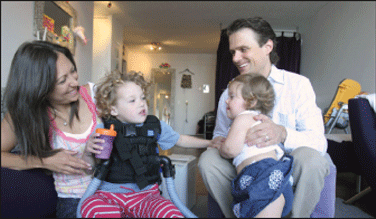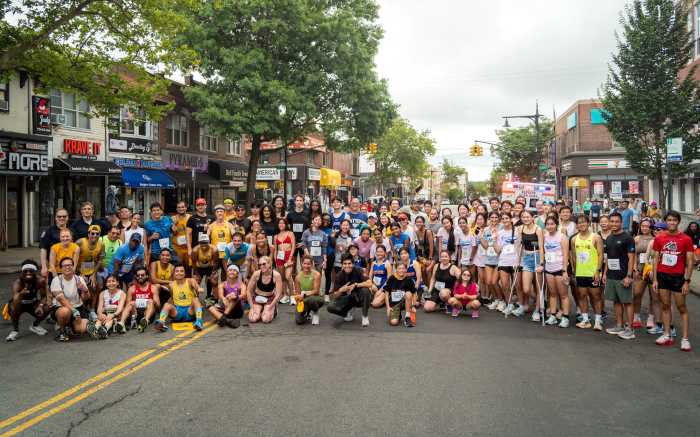By Jennifer Milne
On a sunny Monday morning, Stanley Zolek runs around his Battery Park City apartment, grinning, like a normal 3-year-old. He brings his mom, Dawn Zolek, a box of cereal to eat, but she tells him he needs a bowl from the kitchen. On his toddle back to the kitchen, Stanley coughs.
It’s a deep, throaty cough and one can hear the sound of the thick mucus built up inside Stanley’s lungs. The cough is not part of a cold that will go away with medication or time: It’s cystic fibrosis. Stanley is one of 30,000 Americans (70,000 people worldwide) with cystic fibrosis. C.F. is a genetic disease wherein a faulty gene causes a thick mucus to build up inside the lungs, hindering breathing. Stanley’s pancreas is also surrounded by a layer of mucus, so his natural digestive enzymes can’t break through it to get to the food. Stanley must eat enzymes with every meal and snack to ensure he’s able to digest his food properly.
And yet, he bounces and rolls and laughs on the floor like a perfectly healthy child. His blonde curls match those of his 1-year-old sister, Skylar, and the two of them race around the apartment, giggling.
“We want people to understand that he is a completely normal kid, but he does have his challenges,” said Dawn, 35, in an interview. “We don’t want him to be treated differently.”
As part of their crusade to help more people understand exactly what cystic fibrosis is and how it affects the body, Dawn and her husband Stan, 36, are chairing the Cystic Fibrosis Foundation’s Great Strides Walk in Battery Park City for the second year. The Zoleks became involved three years ago when Stanley was born. That year, the walk was held at Carl Schurz Park on the Upper East Side, and they had Stanley do the honor of cutting the ribbon.
But in 2006, the following year, when the Zoleks took over, they moved the walk to Battery Park City, where they’ve lived for ten years, and saw a tremendous increase in participation – up 91 percent from 2005 – and donations. Dawn credits the success to moving the walk to Lower Manhattan.
“We saw the surrounding community didn’t support the walk like should be supported,” she said. “This is more like a community.”
This year, the Zoleks expect 500 walkers, including those supporting their own walk team, “Stanley’s City Slickers.” They’ve already raised $40,000 for the 2007 walk, more than half of the $75,000 from the previous two years combined. Dawn says the fundraising for the event has been very “grassroots,” and that 91 cents of every dollar goes to the Cystic Fibrosis Foundation.
“A lot of the support comes from family and friends,” she said. “We also try to get people and their companies involved.”
The New York Mercantile Exchange in B.P.C., where Stan works, has already pledged $25,000 to support the event, and the Zoleks are planning on turning it into an all-day event to help spread awareness.
“We want more people to know,” Dawn said. “Even if people have heard of C.F., they don’t know what it is.”
Although care for people with cystic fibrosis is well managed by the Zoleks and many families, C.F. (called “65 roses” by children who can’t pronounce the medical name) is still a life-threatening disease. As of today, Stanley’s life expectancy is about 36 years, but it’s increasing all the time. Stanley’s daily treatment involves two 30-minute sessions in a vibrating vest that helps loosen up the mucus in his chest (replacing the old method of striking the palm of the hand against the chest), and enzymes with every meal and snack. He also takes Xopenex, a form of albuterol, to help loosen up his breathing passageways. Dawn said the invention of the vibrating vest a few years ago and other medical advancements have made a big difference.
“Before, you had to use the old method,” she said. “It has changed our lives and how we care for him.”
But the Zoleks still have to be careful about protecting Stanley’s health. So far, he’s had five chest X-rays and he contracted pseudomonas, a bacterium that affects the respiratory tract, when he was one. He was also hospitalized two weeks ago due to a blockage in his large intestine, but Dawn says he was a “trooper.” Once out of the hospital, Stanley was right back to his activities, soccer and tae kwon do.
Stanley’s immune system is compromised by cystic fibrosis, so he has more chances of getting sick than his peers. His father, Stan, said “when he gets a cold, it takes a lot longer to get better.” Stan likes to use an analogy to help people understand how the mucus in Stanley’s lungs can trap germs and cause an infection.
“It’s like a tar driveway in August,” Stan said. “Everything sticks to it.”
The Zoleks also have to be careful at C.F. events, because two people with cystic fibrosis cannot be near one another for fear of infection.
“Two C.F. kids shouldn’t be in the same room with one another,” Stan said. “If we go to an event or dinner, they’ll sit two C.F. people at opposite ends of the table.”
Dawn, who is part of the Hudson River Park Mother’s Group, says one of the hardest things is having people not be insulted when she needs to remove Stanley from a playground or situation because of the presence of another sick child.
“You see people shying away because they don’t know how to handle it,” Dawn said.
As for Stanley, Dawn hopes that as he grows up, his friends and peers will better understand cystic fibrosis and there will no longer be a stigma attached to the disease.
“As he gets older and deals with it more on his own, hopefully by then more of his peers will be aware of the situation,” Dawn said.
Until there is a cure for C.F., there are ways for parents to identify whether they are carriers of the defective gene. For people who think they may be a carrier of the cystic fibrosis gene, or those who want to be tested before becoming pregnant, there is genetic testing. The Zoleks used something known as P.G.D. – pre-implantation genetic diagnosis – when they had their daughter. P.G.D. involves testing individual embryos to determine which will not be afflicted by C.F. and will be the most likely to survive.
What the Zoleks want to see for Stanley in the future, besides a cure, is a shift in how C.F. patients are treated. Dawn said hospital visits can be traumatic for Stanley.
“I’d like to see more in-home therapy as opposed to hospitalizations,” she said. “I just want to make it more normal for a child, so that it could be done at home.”
In addition, Dawn said in an e-mail that increased support and funding for the foundation allows it to continue its research to provide new therapies for patients.
“With the research and available therapies, Stanley and others could have the same opportunity at living a full life,” Dawn said.
In the meantime, the Zoleks are canvassing New York City, spreading the word about Stanley, the Great Strides Walk and C.F. They have “wild postings” – a wall of posters featuring Stanley’s smiling face – in over 500 places, and Toys ‘R’ Us put Stanley on their Times Square billboard. This year marks the third year Stanley’s face has beamed down, and it will be on display for a two-week period ending Monday, May 21. Dawn says Stanley was shy when they first took him to Times Square, but then he wanted to go back and see himself on the billboard’s big screen.
Dawn and Stan said in addition to spreading awareness, they want to give C.F. a face.
And so they gave New York Stanley’s face, and his bright smile.
The Great Strides Walk starts in Battery Park near Castle Clinton at 10 a.m. Sat., May 19 and will proceed up the Hudson River walkway to Stuyvesant High School and back to the park. For more information, visit www. cff.org/great_strides or www .ilovestanleynyc.com.


























